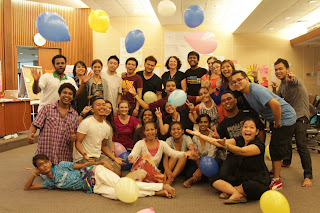 |
| courtesy of typs.org.uk |
It's very obvious I knew what she was there for, as well was the fact she knew the exact same of myself. She happens to be the daughter of someone I've known for many years, and I hadn't had a clue about her diagnosis. From the moment I saw her until I got out of there all that kept running through my mind was what was going to come out and what was going to be said. From the original day I was diagnosed I kept my issues to myself (and wife).
A few weeks later I ran into her father and we talked about many things, and I'm so glad not a word was mentioned about any doctors or my seeing his daughter at her appointment; after all, the doctor's office is specifically for HIV/AIDS patients. I haven't seen this person in a while now, but I'm sure glad she didn't say a word about anything.
You see I'm the kind of guy who has to be bleeding from the eyes, to be going to a hospital or the doctor's (except now) and I hold my cards very close to the vest as a means to protect myself from those who don't know or are just opinionated on issues they have no knowledge of.
Just two weeks ago it was let out again, to someone who used to treat me as a friend, and don't you know he's got the biggest mouth there is, as well as the totally wrong outlook on the HIV issue and its real implications to a person's body, and the means in which we contract HIV. He's one of those who think anyone who has it must be dirty, or a lesser person than he is. I had been around him even before I was diagnosed, and to sit and hear some of the things that come out of his mouth would have dropped the average person; but me, I'm not so easy a target. I just listen to him ramble his ideas and incorrect thoughts.
All the while, he had not a clue he was preaching the uninformed lesson to the choir, so to speak. As time went on I slowly slipped some information (always use condoms) to his teen kids without them knowing I had HIV. It's because I do understand a lot of medical issues, and have gone through so many, I have learned so much that I wasn't ever worried about saying what I thought.
As I wrote in the title, it's more the people who worry me the most now that I know what to do with my health. It used to be I worried about this virus. It's really ironic that someone you have known for so long can turn into someone you never knew after all; they were just somebody whose name and phone number you knew, that's all.
It's sad when you realize things truly aren't what they seem, when for years things were good. All the uninformed and misinformed people are the ones who suffer silently because they just don't get it. Sure I suffer in silence too, but I suffer for different reasons. As I'm getting older I become more guarded with who I allow myself to call a friend, and it's really disheartening to me, because I'm the kind of guy who will be out having fun telling jokes and trying to get other people into a good mood. Maybe this is the part where I grow up finally. I have been called a big kid long enough.
I just don't like the seriousness of how people can still be so naive to such a big health issue. HIV is still around and I have seen it firsthand -- both the caring and the not caring at all. Kind of like being on a listing ship; flip a coin and decide which way it's going to turn over. It can be bothersome most times, but, then there are times I don't care and I say it the way I see it.
I hope that ex-friend calls me one more time, so I can tell him, "Sorry, but I can't speak right now, I have HIV and I heard you can catch it through the phone now" -- then just hang up and leave that part of my life gone for good.
______________________________________________________________________
The article was initially published in thebody.com on October 23, 2012.





